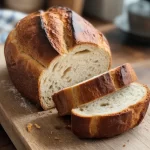I explore How To Make A Baguette and uncover the simple science and timing behind an authentic-looking loaf made from just a few pantry ingredients.

I never thought I’d get bakery results using just bread flour and a little active dry yeast, but here we are. The crust turns so golden and loud you have to snap a pic, and the inside stays airy in a way that makes me question every store bought loaf.
This recipe taught me how simple a Crispy Baguette can be, and why people obsess over French Baguettes. No fancy tools, a bit of patience and you’ll be surprised.
I messed up the first time, but that mistake led to a trick I now use all the time.
Ingredients

- Bread flour: High protein flour, makes chewy crumb and structure, adds more protein than all purpose
- Water: Hydrates dough, controls texture and crust, no calories but affects fermentation
- Yeast: Leavens the dough, adds aroma and slight tang through fermentation, tiny bit of nutrients
- Salt: Boosts flavor and strengthens gluten, helps control yeast, too much is unhealthy
- Olive oil (optional): Softens crumb and adds rich flavor, provides healthy fats but optional for classic baguette
- Extra flour or cornmeal (optional): Used for dusting, prevents sticking and adds rustic crunch, mostly carbs, no protein
Ingredient Quantities
- Bread flour 500 g (about 4 cups) – use bread or high protein all purpose flour
- Water 350-375 g (about 1 1/2 cups)
- Active dry yeast 2 1/4 tsp (7 g) or instant 2 1/4 tsp
- Fine sea salt 10 g (about 1 3/4 tsp)
- Optional: olive oil or melted butter 1 tbsp (for brushing)
- Optional: extra flour or cornmeal for dusting 1-2 tbsp
How to Make this
1. If using active dry yeast, dissolve 2 1/4 tsp (7 g) yeast in 100-110°F (38-43°C) of the 350-375 g water and let sit 5-10 minutes until foamy; if using instant yeast just mix it into the flour.
2. Put 500 g bread flour in a bowl, pour in about 350 g of the water and mix with a spoon until no dry bits remain; this autolyse for 20-30 minutes helps a better open crumb. Add more water (up to 375 g) only if the dough feels too stiff.
3. After autolyse add the yeast (or the yeast-water) and 10 g fine sea salt; mix until a shaggy dough forms, then knead 6-8 minutes by hand (slap and fold) or 4-5 minutes in a stand mixer until the dough is smooth and slightly tacky.
4. Bulk ferment at room temp for about
1.5-2 hours until it looks puffy and a bit risen; do 3 sets of stretch-and-folds every 20-30 minutes during this time to strengthen the dough.
5. Optional: for deeper flavor, put the dough in the fridge for 8-18 hours after the first fold instead of finishing at room temp, then bring back to room temp before shaping.
6. Turn dough out gently, divide into 2 or 3 pieces (depending on baguette size you want), pre-shape into loose logs and bench rest 15-20 minutes covered so the gluten relaxes.
7. Shape each piece into a baguette: flatten to a rectangle, fold the long edge to the center, seal the seams by rolling toward you to tighten the loaf; try not to degas the dough too much.
8. Proof seam-side down on a well-floured couche or a parchment-lined, cornmeal-dusted baking sheet for 45-60 minutes until puffy but not collapsing; for a slower proof you can refrigerate again for up to a few hours.
9. Meanwhile preheat oven to 475°F (245°C) with a baking stone or heavy sheet inside and place an empty metal tray on the bottom rack for steam. Just before baking, score each loaf 3-5 times with a sharp lame or knife, quickly pour 1 cup boiling water into the bottom tray to create steam or spray water twice in the oven, then slide loaves in.
10. Bake 18-25 minutes until deep golden and crisp, remove the steam tray after the first 8-10 minutes if you want a darker crust. Brush with 1 tbsp olive oil or melted butter if you like a slightly softer, shinier crust, cool on a rack at least 20-30 minutes before slicing.
Equipment Needed
1. Digital kitchen scale — for weighing flour, water, yeast and salt
2. Large mixing bowl (stainless or glass) for autolyse and bulk ferment
3. Wooden spoon or sturdy spatula for the initial mix
4. Bench scraper or dough scraper to divide and shape the loaves
5. Stand mixer with dough hook (optional, you can knead by hand)
6. Proofing couche or a well floured tea towel, or a parchment lined baking sheet dusted with cornmeal
7. Baking stone or heavy baking sheet to bake on
8. Empty metal tray to create steam in the oven and a pair of oven mitts
9. Sharp lame or serrated knife for scoring and a cooling rack to cool the loaves
FAQ
The Easiest Baguette Recipe: Crispy, Chewy & Bakery Substitutions and Variations
- Bread flour: If you dont have it, use 500 g all purpose flour plus 20–25 g vital wheat gluten to get similar chew. If you must use plain AP only, expect a softer, less chewy crumb.
- Water: Swap 100–150 g of the water for whole milk for a richer, softer interior and a browner crust. Cold water slows fermentation, warm water (95–105 F) speeds it up.
- Yeast: Replace active dry with fresh yeast at about 3 times the weight, so ~21 g fresh for 7 g active dry. Instant yeast works interchangeably with active dry at the same weight.
- Dusting (cornmeal or extra flour): Use semolina for a crunchy bottom, or rice flour to prevent sticking without burning, or just use parchment if you dont want any grit on the crust.
Pro Tips
– Trust the feel more than the numbers. Start with the lower water, let the dough autolyse, then add more only if it still feels stiff. A slightly tacky, stretchy dough gives a more open crumb, but dont make it soupy or you wont be able to shape it.
– Slow, cool fermentation makes better flavor. If you can, use less yeast and refrigerate for many hours after the first strengthen, bring back to room temp before shaping. Watch the poke test, when the dent springs back slowly but not all the way, thats your cue to bake.
– Work on surface tension when you shape. Tighten the skin without smashing all the gas, wet your hands a bit if the dough sticks, and seal the seam well so the loaf holds its shape and gets good oven spring.
– Score sharply and create real steam in the first minutes of baking. Use a very sharp blade at a low angle and cut confidently, add hot water to a tray or spray the oven for steam and remove it after about 8 to 10 minutes for a darker crust. Brush with a little oil or butter after cooling just a touch if you want a softer, shinier crust.

The Easiest Baguette Recipe: Crispy, Chewy & Bakery
I explore How To Make A Baguette and uncover the simple science and timing behind an authentic-looking loaf made from just a few pantry ingredients.
12
servings
152
kcal
Equipment: 1. Digital kitchen scale — for weighing flour, water, yeast and salt
2. Large mixing bowl (stainless or glass) for autolyse and bulk ferment
3. Wooden spoon or sturdy spatula for the initial mix
4. Bench scraper or dough scraper to divide and shape the loaves
5. Stand mixer with dough hook (optional, you can knead by hand)
6. Proofing couche or a well floured tea towel, or a parchment lined baking sheet dusted with cornmeal
7. Baking stone or heavy baking sheet to bake on
8. Empty metal tray to create steam in the oven and a pair of oven mitts
9. Sharp lame or serrated knife for scoring and a cooling rack to cool the loaves
Ingredients
-
Bread flour 500 g (about 4 cups) – use bread or high protein all purpose flour
-
Water 350-375 g (about 1 1/2 cups)
-
Active dry yeast 2 1/4 tsp (7 g) or instant 2 1/4 tsp
-
Fine sea salt 10 g (about 1 3/4 tsp)
-
Optional: olive oil or melted butter 1 tbsp (for brushing)
-
Optional: extra flour or cornmeal for dusting 1-2 tbsp
Directions
- If using active dry yeast, dissolve 2 1/4 tsp (7 g) yeast in 100-110°F (38-43°C) of the 350-375 g water and let sit 5-10 minutes until foamy; if using instant yeast just mix it into the flour.
- Put 500 g bread flour in a bowl, pour in about 350 g of the water and mix with a spoon until no dry bits remain; this autolyse for 20-30 minutes helps a better open crumb. Add more water (up to 375 g) only if the dough feels too stiff.
- After autolyse add the yeast (or the yeast-water) and 10 g fine sea salt; mix until a shaggy dough forms, then knead 6-8 minutes by hand (slap and fold) or 4-5 minutes in a stand mixer until the dough is smooth and slightly tacky.
- Bulk ferment at room temp for about
- 5-2 hours until it looks puffy and a bit risen; do 3 sets of stretch-and-folds every 20-30 minutes during this time to strengthen the dough.
- Optional: for deeper flavor, put the dough in the fridge for 8-18 hours after the first fold instead of finishing at room temp, then bring back to room temp before shaping.
- Turn dough out gently, divide into 2 or 3 pieces (depending on baguette size you want), pre-shape into loose logs and bench rest 15-20 minutes covered so the gluten relaxes.
- Shape each piece into a baguette: flatten to a rectangle, fold the long edge to the center, seal the seams by rolling toward you to tighten the loaf; try not to degas the dough too much.
- Proof seam-side down on a well-floured couche or a parchment-lined, cornmeal-dusted baking sheet for 45-60 minutes until puffy but not collapsing; for a slower proof you can refrigerate again for up to a few hours.
- Meanwhile preheat oven to 475°F (245°C) with a baking stone or heavy sheet inside and place an empty metal tray on the bottom rack for steam. Just before baking, score each loaf 3-5 times with a sharp lame or knife, quickly pour 1 cup boiling water into the bottom tray to create steam or spray water twice in the oven, then slide loaves in.
- Bake 18-25 minutes until deep golden and crisp, remove the steam tray after the first 8-10 minutes if you want a darker crust. Brush with 1 tbsp olive oil or melted butter if you like a slightly softer, shinier crust, cool on a rack at least 20-30 minutes before slicing.
Notes
- Below you’ll find my best estimate of this recipe’s nutrition facts. Treat the numbers as a guide rather than a rule—great food should nourish both body and spirit. Figures are approximate, and the website owner assumes no liability for any inaccuracies in this recipe.
Nutrition Facts
- Serving Size: 72g
- Total number of serves: 12
- Calories: 152kcal
- Fat: 0.6g
- Saturated Fat: 0.02g
- Trans Fat: 0g
- Polyunsaturated: 0.2g
- Monounsaturated: 0.3g
- Cholesterol: 0mg
- Sodium: 323mg
- Potassium: 45mg
- Carbohydrates: 32g
- Fiber: 1.4g
- Sugar: 0.1g
- Protein: 5g
- Vitamin A: 0IU
- Vitamin C: 0mg
- Calcium: 6mg
- Iron: 0.5mg
















